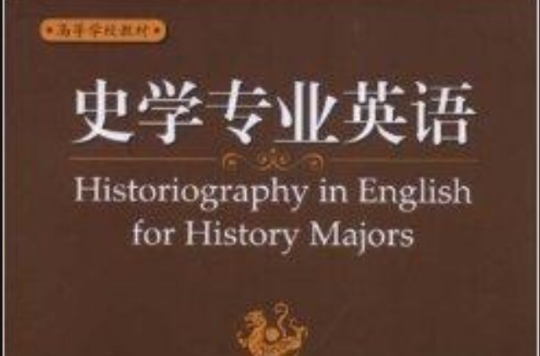《史學專業英語》通過世界歷史和中國歷史兩條主線,以為學生提供一本編年簡史類的專業英語教材。書中的選材涉及了政治、經濟、戰爭、條約、宗教、科學技術、文化思想等廣泛的領域;教材精選了部分原始文檔,節選了部分國外和國內著名歷史學家和政治家的英文原版論著和英譯名著,強化了史學的學術性和英語語言的學術性。《史學專業英語》分兩大部分:世界史22章,中國史12章。每章開始簡單介紹本章涵蓋內容,主體由兩部分組成:A.某段通史資料;B.文獻史料或論著節選。隨後有歷史和語言難點的注釋,最後是思考問答題和翻譯練習題。
基本介紹
- 書名:史學專業英語
- 作者:高芳英 范菊華
- 出版日期:2008年9月1日
- 語種:簡體中文, 英語
- ISBN:9787800809262, 7800809269
- 外文名:Historiography in English for History Majors
- 出版社:群言出版社
- 頁數:241頁
- 開本:16
- 品牌:群言出版社
基本介紹
內容簡介
作者簡介
范菊華,博士1962年生,男,江蘇蘇州人。歷史學副教授。先後從事中國小英語教學,大學英語和歷史專業教學,並先後獲英語語言文學碩士和歷史學博士學位,現任蘇州大學社會學院歷史系碩士生導師,承擔世界歷史,當代國際關係和史學專業英語等課程的教學。研究方向為二十世紀國際關係、國際關係史學與理論,主治西方國際關係理論和全球氣候變化,出版專著《國際制度的建構主義分析》,在《世界經濟與政治》、《現代國際關係》、《國外社會科學》、《讀書》等刊物發表論文數篇。
圖書目錄
Part One Western Civilization
Ⅰ、The Ancient World: Foundations of the West To A. D. 500
1、The Ancient Near East: The First Civilizations
2、The Greeks: From Myth to Reason
3、The Romans: From City-State to World Empire
4、Early Christianity: A World Religion
Ⅱ、The Middle Ages: The Christian Centuries A. D. 500-1400
5、The Rise of Europe: Fusion of Classical, Christian, and German Traditions
6、The Flowering of Medieval Civilization: The Christian Synthesis
Ⅲ、The Rise of Modernity: From the Renaissance to the Enlightenment 1350 -1789
7、Transition to the Modern Age: Renaissance and Reformation
8、Political and Economic Transformation: National States, Overseas Expansion,Commercial Revolution
9、Intellectual Transformation: The Scientific Revolution and the Age of Enlightenment
Ⅳ、The Modern West: From the Bourgeoisie Revolution to the Industrial Age 1640-1914
10、The Triumph of England's Parliament: Constitutional Monarchy and Cabinet Government
11、The American Revolution: Independence and Civil War
12、The Era of the French Revolution: The Affirmation of Liberty and Equality
13、Ferment of Ideas: Romanticism, Conservatism, Liberalism, Nationalism
14、The Industrial Revolution: The Transformation of Society
15、Europe in the Industrial Age: Modernization and Imperialism
Ⅴ、Western Civilization in Crisis: World Wars and Totalitarianism 1914-1945
16、World War I: The West in Despair
17、The Soviet Union: Modernization and Totalitarianism
18、The Era of Fascism: The Attack on Reason and Freedom
19、World War II: Western Civilization in the Balance
Ⅵ、The Contemporary World: The Global Age Since 1945
20、Europe After 1945: Recovery, Realignment, Division
21、U.S. After 1945: Hegemonic Position
22、The New Globalism: Problems and Prospects
Part Two Chinese Civilization
Ⅰ、Ancient Chinese Civilization: One of the Four Great Ancient Civilizations
1、Four Great Inventions: the Compass, Gunpowder, Papermaking,and Printing
2、Three Schools of Thoughts in Ancient: Confucianism, Taoism, Buddhism
3、The First Emperor of Imperial China: Qin Shi Huangdi
4、The Greatest Dynasty of Imperial China: Hen Dynasty
5、The Classical Literature: The Poetry in Tang and Song Dynasties
Ⅱ、Emergence of Modern China: The Semi-Colonial and Semi-Feudalism China
6、The Opium War: Western Powers Arrive
7、The Growing up of the Chinese Modem History: The Self-Strengthening Movement
8、The Revolution of 1911 : Turning Point in Modern Chinese History
Ⅲ、Modern Chinese Polities: From “Dark” to ”Bright”
9、The New Culture Movement: the Basis for May Fourth Movement
10、Rise of the Communists: Leader Mao Zedong
11、Anti-Japanese War: Kuomintang and CCP United Front Against Japan
12、Civil War: the Triumph of Communist Party
Main References
Postscript
文摘
Physically the term polls designated a city or town and its surrounding countryside.Thetypical polis consisted of people living in a compact group of houses within the city.The city’s water supply came from public fountains and cisterns.By the fifth century B.C.the city was generally surrounded by a wall.The city contained a point,usually elevated,called the“acropolis.”and a public square or marketplace(agora).On the acropolis,which in the early period was a place of refuge,stood the temples,altars,public monuments,and various dedications to the gods of the polis.The agora was originally the place where the warrior assembly met,but it became the political center of the polis.In the agora were porticoes,shops,and public buildings and courts.
The polis was far more than a political institution.Above all it was a community of citizens.and the affairs of the community were the concern of all citizens.The intimacy ofthe polis was an important factor,one hard for modern city dwellers to imagine.The philosopher Plato thought that five thousand citizens constituted the ideal population for a polis.Though utopian,Plato was not in this case being unrealistic.Although populationfigures for Greece are mostly guesswork,because most city-states were small enough not to need a census.the polis of Thebes in Boeotia is a useful illustration of how small a Greek state was.When Alexander the Great destroyed Thebes in 335 B.C.,he sold thirty thousand people into slavery.Some six thousand people had died in the fighting,and many others he spared.Thus the free population of Thebes had numbered between thirty and forty thousand at most,and Thebes was a large polis,a major power.
後記
另外,我的同事范菊華老師,是獲得英語語言文學碩士和歷史學博士學位的雙料學者,我們倆的合作為本教材的順利編寫奠定了重要的基礎。
本教材各章編寫分工如下:
世界史部分:第1-9,11,13,21章,高芳英;第10,12,14-20章的簡單介紹和A部分及部分注釋和思考問答題,高芳英;第10,12,14-20章的B部分及部分注釋和翻譯練習題,范菊華;第22章,范菊華。
中國史部分:第l-6章,范菊華;第6-12章,高芳英。
前言和後記,高芳英。
序言
長期以來,我國高等院校歷史學專業的學生缺乏專業英語課程的教材,大多數院校的專業英語教材是根據授課教師的專業方向臨時編印的,難免在專業英語綜合知識結構方面有所欠缺。本教材通過世界歷史和中國歷史兩條主線,用英語編撰歷史,為學生提供了一本編年簡史類的專業英語教材。
本教材的主要特點是體系完整、內容廣泛、學術性強,能夠培養和訓練學生用英語在本專業內參與國際交流的能力。教材的編撰從古代美索不達米亞文明到2l世紀的經濟全球化,從中國古代的四大發明到新中國的建立,體現了古今中外歷史的完整體系;教材的內容涉及了政治、經濟、戰爭、條約、宗教、科學技術、文化思想等廣泛的領域;教材精選了部分原始文檔,節選了部分國外和國內著名歷史學家和政治家的英文原版論著和英譯名著,強化了史學的學術性和英語語言的學術性。
本教材分兩大部分:世界史22章,中國史12章。每章開始簡單介紹本章涵蓋內容,主體由兩部分組成:A、某段通史資料;B、文獻史料或論著節選。隨後有歷史和語言難點的注釋,最後是思考問答題和翻譯練習題。
本教材的編寫得到了蘇州大學社會學院領導的大力支持和鼓勵,在此表示真摯的感謝。
由於編者的水平有限,教材中的不妥之處敬請讀者批評指正。
另外,教材所選的資料,尤其是西方史學家和政治家的論著,其觀點請讀者正確對待。

